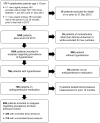Racial disparities in the prevalence and control of hypertension among a cohort of HIV-infected patients in the southeastern United States
- PMID: 29596462
- PMCID: PMC5875791
- DOI: 10.1371/journal.pone.0194940
Racial disparities in the prevalence and control of hypertension among a cohort of HIV-infected patients in the southeastern United States
Abstract
Background: African Americans are disproportionately affected by both HIV and hypertension. Failure to modify risk factors for cardiovascular disease and chronic kidney disease such as hypertension among HIV-infected patients may attenuate the benefits conferred by combination antiretroviral therapy. In the general population, African Americans with hypertension are less likely to have controlled blood pressure than whites. However, racial differences in blood pressure control among HIV-infected patients are not well studied.
Methods: We conducted a cross-sectional study evaluating racial differences in hypertension prevalence, treatment, and control among 1,664 patients attending the University of Alabama at Birmingham HIV Clinic in 2013. Multivariable analyses were performed to calculate prevalence ratios (PR) with 95% confidence intervals (CI) as the measure of association between race and hypertension prevalence and control while adjusting for other covariates.
Results: The mean age of patients was 47 years, 77% were male and 54% African-American. The prevalence of hypertension was higher among African Americans compared with whites (49% vs. 43%; p = 0.02). Among those with hypertension, 91% of African Americans and 93% of whites were treated (p = 0.43). Among those treated, 50% of African Americans versus 60% of whites had controlled blood pressure (systolic blood pressure <140 mmHg and diastolic blood pressure <90 mmHg) (p = 0.007). After multivariable adjustment for potential confounders, prevalence of hypertension was higher among African Americans compared to whites (PR 1.25; 95% CI 1.12-1.39) and prevalence of BP control was lower (PR 0.80; 95% CI 0.69-0.93).
Conclusions: Despite comparable levels of hypertension treatment, African Americans in our HIV cohort were less likely to achieve blood pressure control. This may place them at increased risk for adverse outcomes that disproportionately impact HIV-infected patients, such as cardiovascular disease and chronic kidney disease, and thus attenuate the benefits conferred by combination antiretroviral therapy.
Conflict of interest statement
Figures


Similar articles
-
Racial differences in abnormal ambulatory blood pressure monitoring measures: Results from the Coronary Artery Risk Development in Young Adults (CARDIA) study.Am J Hypertens. 2015 May;28(5):640-8. doi: 10.1093/ajh/hpu193. Epub 2014 Nov 4. Am J Hypertens. 2015. PMID: 25376639 Free PMC article. Clinical Trial.
-
Racial/ethnic differences in hypertension and hypertension treatment and control in the multi-ethnic study of atherosclerosis (MESA).Am J Hypertens. 2004 Oct;17(10):963-70. doi: 10.1016/j.amjhyper.2004.06.001. Am J Hypertens. 2004. PMID: 15485761
-
Perceived Social Standing, Medication Nonadherence, and Systolic Blood Pressure in the Rural South.J Rural Health. 2016 Spring;32(2):156-63. doi: 10.1111/jrh.12138. Epub 2015 Sep 3. J Rural Health. 2016. PMID: 26334761 Free PMC article.
-
The management of hypertension in African Americans.Crit Pathw Cardiol. 2007 Jun;6(2):67-71. doi: 10.1097/HPC.0b013e318053da59. Crit Pathw Cardiol. 2007. PMID: 17667868 Review.
-
Difficult-to-treat hypertensive populations: focus on African-Americans and people with type 2 diabetes.J Hypertens Suppl. 1999 Feb;17(1):S19-24. J Hypertens Suppl. 1999. PMID: 10340840 Review.
Cited by
-
Hypertension and one-year risk of all-cause mortality among women with treated HIV in the United States.AIDS. 2023 Mar 15;37(4):679-688. doi: 10.1097/QAD.0000000000003461. Epub 2022 Dec 23. AIDS. 2023. PMID: 36728933 Free PMC article.
-
Hypertension burden, treatment, and control among people with HIV at a clinical care center in the Southeastern US, 2014-2019.AIDS Care. 2023 Oct;35(10):1594-1603. doi: 10.1080/09540121.2022.2148626. Epub 2022 Dec 16. AIDS Care. 2023. PMID: 36524873 Free PMC article.
-
Prevention of cardiovascular disease for historically marginalized racial and ethnic groups living with HIV: A narrative review of the literature.Prog Cardiovasc Dis. 2020 Mar-Apr;63(2):142-148. doi: 10.1016/j.pcad.2020.02.006. Epub 2020 Feb 11. Prog Cardiovasc Dis. 2020. PMID: 32057785 Free PMC article. Review.
-
Evaluation of New Hypertension Guidelines on the Prevalence and Control of Hypertension in a Clinical HIV Cohort: A Community-Based Study.AIDS Res Hum Retroviruses. 2024 Apr;40(4):223-234. doi: 10.1089/AID.2022.0063. Epub 2023 Sep 7. AIDS Res Hum Retroviruses. 2024. PMID: 37526367 Free PMC article.
-
Why Do People Living with HIV Adhere to Antiretroviral Therapy and Not Comorbid Cardiovascular Disease Medications? A Qualitative Inquiry.Patient Prefer Adherence. 2020 Jun 16;14:985-994. doi: 10.2147/PPA.S254882. eCollection 2020. Patient Prefer Adherence. 2020. PMID: 32669837 Free PMC article.
References
-
- Farahani M, Mulinder H, Farahani A, Marlink R. Prevalence and distribution of non-AIDS causes of death among HIV-infected individuals receiving antiretroviral therapy: a systematic review and meta-analysis. Int J STD AIDS. 2017. June;28(7):636–650. doi: 10.1177/0956462416632428 - DOI - PubMed
-
- Chow FC, Regan S, Feske S, Meigs JB, Grinspoon SK, Triant VA. Comparison of ischemic stroke incidence in HIV-infected and non-HIV-infected patients in a US health care system. J Acquir Immune Defic Syndr. 2012;60:351–358. doi: 10.1097/QAI.0b013e31825c7f24 - DOI - PMC - PubMed
-
- Islam FM, Wu J, Jansson J, Wilson DP. Relative risk of renal disease among people living with HIV: a systematic review and meta-analysis. BMC Public Health. 2012;12:234 doi: 10.1186/1471-2458-12-234 - DOI - PMC - PubMed
-
- Freiberg MS, Chang CC, Kuller LH, Skanderson M, Lowy E, Kraemer KL, et al. HIV infection and the risk of acute myocardial infarction. JAMA Intern Med. 2013;173:614–622. doi: 10.1001/jamainternmed.2013.3728 - DOI - PMC - PubMed
-
- Chu C, Umanski G, Blank A, Meissner P, Grossberg R, Selwyn PA. Comorbidity-related treatment outcomes among HIV-infected adults in the Bronx, NY. J Urban Health. 2011;88:507–516. doi: 10.1007/s11524-010-9540-7 - DOI - PMC - PubMed
Publication types
MeSH terms
Substances
Grants and funding
LinkOut - more resources
Full Text Sources
Other Literature Sources
Medical
Research Materials

